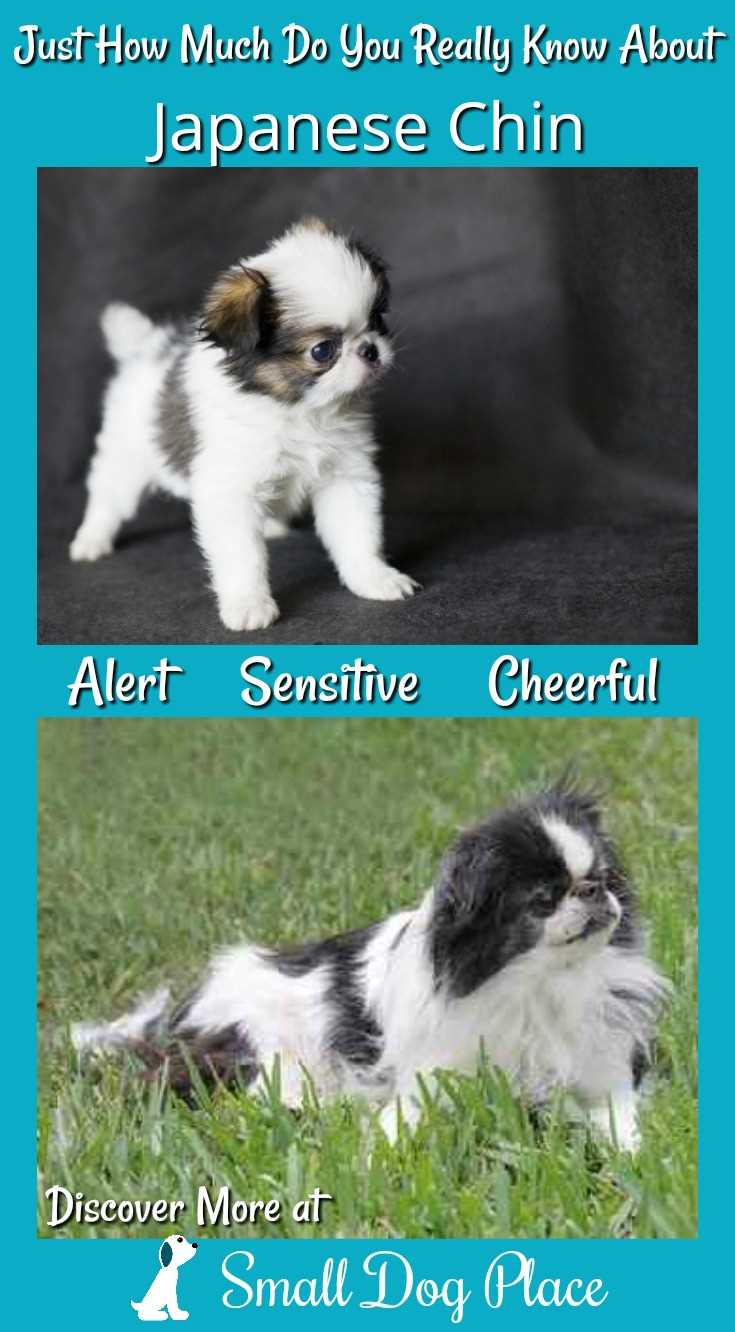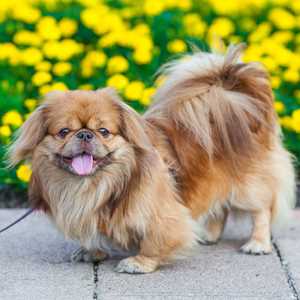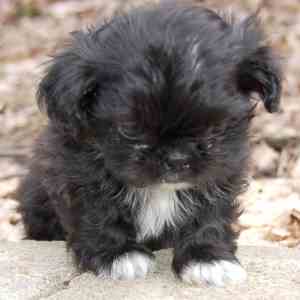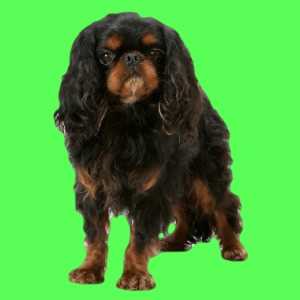- Small Dog Place Home
- A-Z Breeds A to M
- Japanese Chin
Is the Japanese Chin Right For You?
By Janice Jones | Last Updated 07-22-2021
The Japanese Chin is often described as an affectionate, sweet and playful breed.
Often referred to as “Chin” for short, these dogs have also been described as a "feline" dog breed. I will explain oddity shortly. The singular and plural of the Japanese Chin is the same.
While lively and playful, the Chin does not need much in the way of exercise. Most of their requirements can be met by following you around the house. They do enjoy a daily short walk and play session with their favorite human.
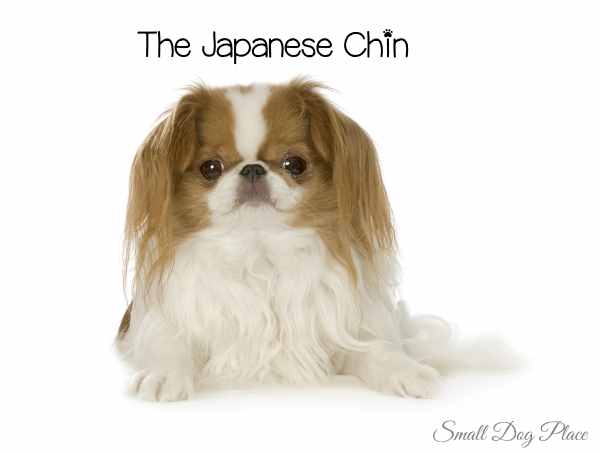
They like the great outdoors but are very sensitive to temperature extremes. They fare better in cooler climates but do not do well in heat and humid conditions. This is not a breed to be left outside.
Some are finicky about rain and snow so if you have one of these, paper training is a must. They make great apartment pets and are a good choice for seniors.
If you’re looking for a dog to hunt, guard, pull or carry things, this is not the breed for you. From early antiquity, these dogs were bred to be companions and that is what they do best.
Most Chins are quiet which is a great big plus for those who do not like yappy dogs. They will bark to let their owners know that someone has arrived at the door.
Their hair coat is straight and silky and tends to stand out from the body, especially around the neck, shoulders, and chest. Their tail is high set and carried over their back with a massive plumb of hair.
Don’t expect your puppy to have a full thick coat as sometimes it takes 2 or 3 years for the coat to fully develop. Oh, and did I mention, the Chin sheds?
The breed standard describes their appearance as having a “distinctive Oriental Expression.”
By this, they are referring to their large flat head and big dark eyes.
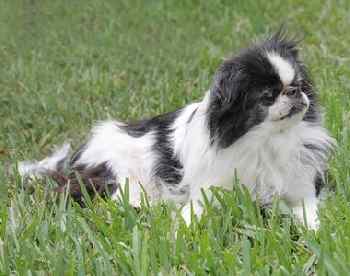
Quick Facts
Other Names Used: Chin
Affiliation: AKC Toy, UK: Companion
Size
Height: 8-11 inches
Weight: The standard does not specify weight but usually 4 pounds to 9 pounds
Coat Type: single layer, semi-long, straight, and silky; they do shed
Colors
Lemon & White
Sable & White
White & Black
Black White & Tan
and black & white with tan points (also referred to as tri colored).
Country of Origin: China & Japan
Activity Level: Moderate
Life Expectancy: 10-12 Years
Good with Children: Older Children only
Good with other pets: Yes, but must be dogs of similar size
History
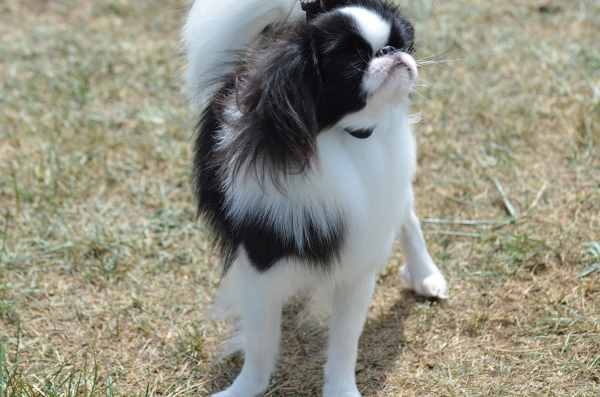
The Japanese Chin is a breed with roots deep in the royalty of both the Chinese and Japanese Courts. Most experts agree that this breed began in China and migrated to Japan with Buddhist Monks.
It is also believed that Buddhist Monks had some involvement in breeding these dogs.
It is likely that at one point, the Japanese Chin and the Pekingese was the same breed. Later, the Pekingese was bred out and the Japanese Chin retained the original look.
In antiquity, the dogs were bred to be small so they could be carried or fitted inside the sleeves of a Noble lady’s kimono. It has been suggested that they were even kept in cages like birds!
As favorite of the Japanese court, this ancient breed could only be owned by the members of the Japanese Imperial family only.
Especially For the Japanese Chin Lover
Buy for yourself. Buy for a Friend. There are many great ideas for dog lovers on Amazon.
In 1853 a pair of these dogs were given to the British Queen Alexandra. She received these dogs as a gift after marrying into the British Royal family in 1863. She became devoted to the breed and was said to have popularized it both in England and in Europe.
Known then as the Japanese Spaniel, it became popular in America where it was registered with the AKC. In 1964 they were honored as one of Japan's national symbols.
The AKC changed the name in 1977. Today the Japanese Chin has a small following in the United States but remains adored in Japan.
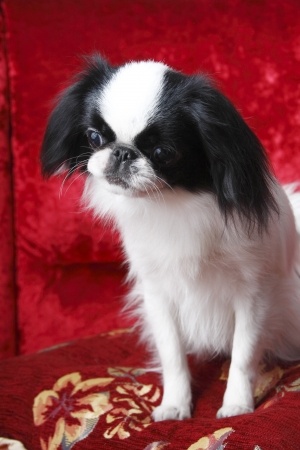 Japanese Chin
Japanese ChinPersonality
| Traits | Rating |
|---|---|
| Playfulness | |
| Affection Level | |
| Friendliness Towards Strangers | |
| Good with Children | |
| Good with Other Dogs | |
| Good for First Time Owners | |
| Exercise Needed | |
| Ease of Training | |
| Watch Dog Ability | |
| Grooming Requirements | |
| Shedding | |
| Cold Tolerant | |
| Heat Tolerant |
Dog Breed Ratings Got You a Little Confused?
Here's a little help in understanding them
- Playfulness: Most Playful = 5 Least Playful = 1
- Affection: Most Affectionate = 5 Least Affectionate = 1
- Friendliness Towards Strangers: Most Friendly = 5 Least = 1
- Good With Children: Great= 5 Not Good with Children = 1
- Good With Dogs: Great = 5 Not Good Around Dogs = 1
- Good With First Time Owners: Fine=5 Not Appropriate = 1
- Exercise Required: Extensive Daily Exercise = 1 Minimal = 1
- Ease of Training: Very Easy = 5 Difficult = 1
- Watch Dog: Excellent Watch Dog = 5 Minimal = 1
- Grooming: Time Consuming = 5 Minimal = 1
- Shedding: Heavy Shedder = 5 Minimal = 1
- Cold Tolerance: Well Tolerated = 5 Poor Tolerance = 1
- Heat Tolerance: Well Tolerated = 5 Poor Tolerance = 1
The Chin is very intelligent and eager to please so training is usually easier with a Japanese Chin.
They are affectionate, mild-mannered and love to keep your lap toasty warm. Socialization is important and makes training much easier for this breed. This is especially important if you don’t want your Chin to be too reserved with strangers.
Some Japanese Chin owners contend that their dogs are adept at sensing their moods. Others have argued that they have an uncanny ability to mimic the family’s moods.
If your family is loud and boisterous, your Chin will be full of energy. If you are quiet and solitary, you are likely to end up with a chin that is well, quiet and solitary!
Another unusual characteristic of the breed is their tendency to be cat-like. Expect to find your Chin perched on the back of your sofa, or grooming himself as if he were a cat. A few licks to the paws then a few paw rubs to the face, your dog has turned into a cat. Hairballs anyone!
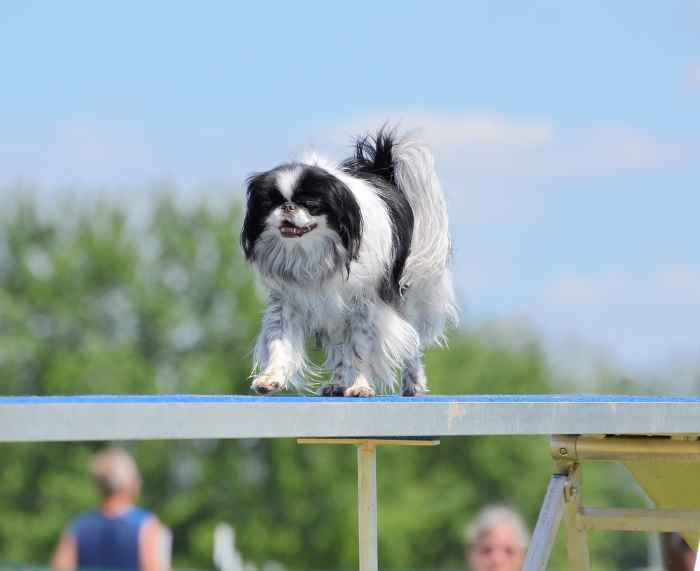 This Japanese Chin is participating in an agility event.
This Japanese Chin is participating in an agility event.The Chin has plenty of self-confidence and tends to decide for himself who will be a friend and who will be a foe. He is also very capable of letting his owner know what he needs.
The old saying that “I’m owned by my dog” couldn’t be truer for a Japanese Chin parent.
His self-confidence comes out in his clownish behaviors. The breed simply loves to perform whether it whether it’s dancing around on hind legs or singing. Yes, singing—they have a rather distinct vocalization called a snizzle or snort. It’s is actually a reverse sneeze due to their face structure.
Grooming
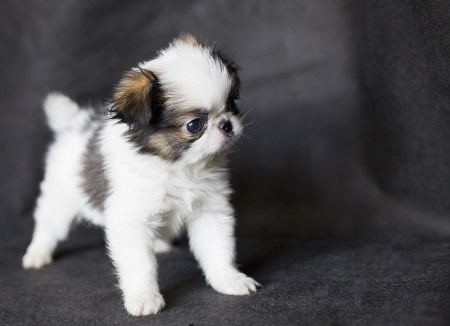 Japanese Chin Puppy
Japanese Chin PuppyYour Chin will not have an adult coat until he is more than a year old. While the puppy grows and matures, the coat fluctuates. During their teenage stage (around 7 to 9 months old) they can be almost naked.
They may have a long coat, but they do not fall into the category of “high maintenance grooming.” Japanese Chins still need regular grooming to keep their gorgeous coat looking top notch.
Brushing and combing should be done about twice a week, A good bath with a high-quality shampoo and conditioner is recommended every few weeks.
As with other long-haired breeds, there are areas of concern that need to be addressed daily.
Some of these include excrement sticking to hair, mats behind the ears, and ears and eyes checked for debris or problems.
Since they have a rather protruding eye, it is important to protect them by daily checks. So, a daily once-over will usually catch anything.
Nails need to be clipped as they grow fast. It’s always advisable to brush their teeth to keep the amount of tartar under control.
An easy way to clean dog teeth is to add baking soda to a damp gauze pad and use friction to rub their teeth. The hair between the toe pads also needs to be clipped. Ears should be cleaned of built-up earwax using a good quality dog ear cleaner.
Professional Grooming every two months will also help keep their flowing locks neat and tidy.
Health Concerns
The Japanese Chin is a healthy breed living 10-12 years on average and up to 15 years. The majority of problems seen in the Chin are common to many small dogs.
Any dog is susceptible to infectious diseases such as Parvo and Distemper and parasites both internal and external do not discriminate by breed. The following are heritable diseases have been identified in the breed.
Do not let the list frighten you, though because while they are potential problems, the chances of any one of them plaguing your puppy are rare.
The best way to assure that you will have a healthy puppy is to purchase directly from a reputable breeder.
Among the most common are:
Luxating patellas (slipping kneecaps)
Early-onset heart murmurs
Keratoconjunctivitis sicca (KCS)
There are many things you can do to keep your dog healthy and these include feeding a high quality diet, regular veterinary care including vaccines and heartworm testing. Heartworm preventative
is highly recommended as well as periodic worming for intestinal worms. Even though the Chin does not need too much exercise, a walk around the block daily will keep him in tip-top shape.
Pros
- Good for people in apartments or condos
- Quiet dogs
- Relatively healthy breed
- Less popular which means less inbreeding
- Easy to train
- Does not require much exercise
Cons
- Sheds
- Requires some grooming
- Very sensitive to heat and humidity
- Not a good breed for very small children
Pin for Future Reference
References & Resources
Similar Breeds to Check Out
About Janice (author and voice behind this site)
Janice Jones has lived with dogs and cats for most of her life and worked as a veterinary technician for over a decade. She has also been a small-breed dog breeder and rescue advocate and holds academic training in psychology, biology, nursing, and mental health counseling. Her work focuses on helping dog owners make informed, responsible decisions rooted in experience, education, and compassion.
When not writing, reading, or researching dog-related topics, she likes to spend time with her six Shih Tzu dogs, her husband, and her family, as well as knitting and crocheting. She is also the voice behind Miracle Shih Tzu and Smart-Knit-Crocheting
Does This Article Deserve Your Thumbs Up?
We always appreciate your support and encouragement. Your thumbs up means so much to us. Please like this article.
If you find this page or any page on Small Dog Place Helpful, or useful in anyway, I'd love it if you would click the small heart found on the bottom right of each page.
You can also share or bookmark this page -- just click on the:

Free Monthly Newsletter
Sign Up for Our Free Newsletter and get our Free Gift to You.
my E-book, The Top 10 Mistakes People Make When Choosing a Dog (and how to avoid them)
